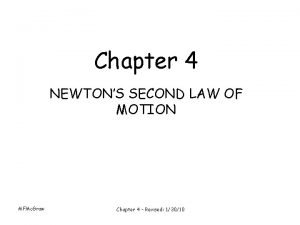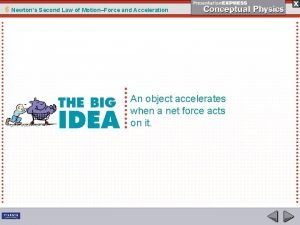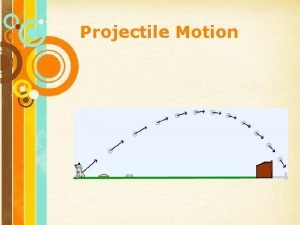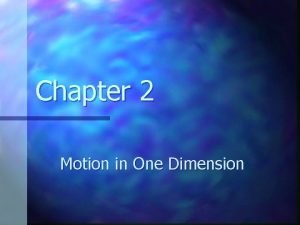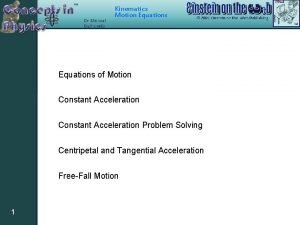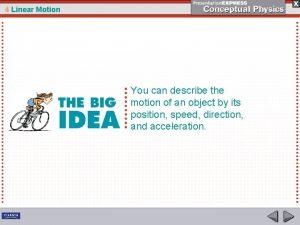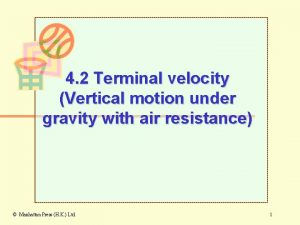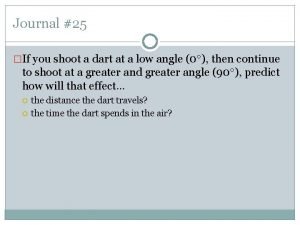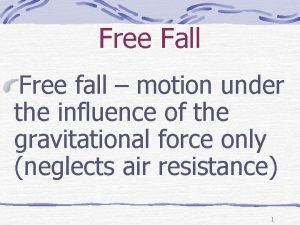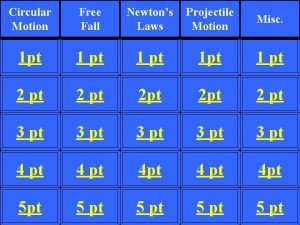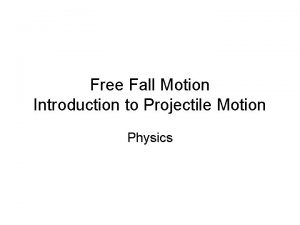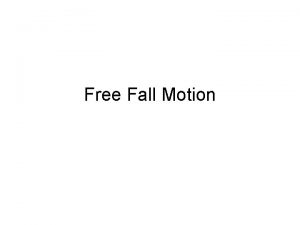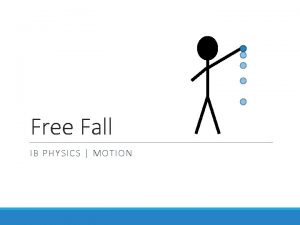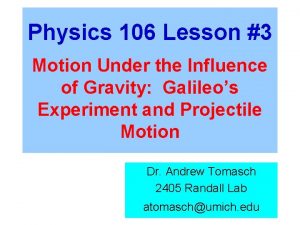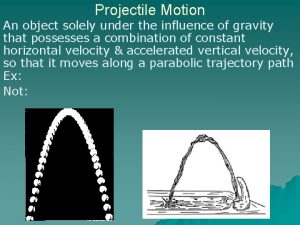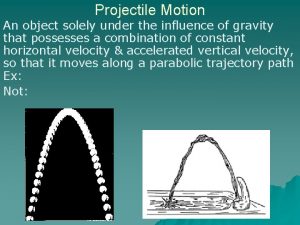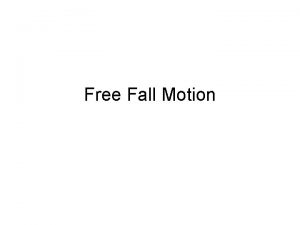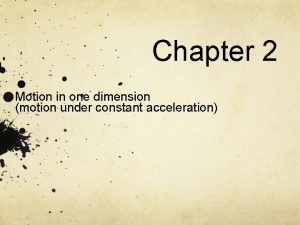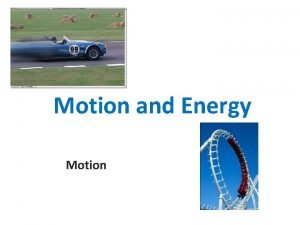Free Fall Free fall motion under the influence






















- Slides: 22

Free Fall Free fall – motion under the influence of the gravitational force only (neglects air resistance) 1

Elapsed time that has passed from the beginning of a fall 2

Gravity and Free fall Acceleration due to gravity is 9. 8 m/s 2, downward Every second that an object falls, the velocity increases by 9. 8 m/s 3

Sample 1 If an object is dropped from rest at the top of a cliff, how fast will it be going after 1 second? 2 seconds? 10 seconds? 4

First, Identify the GIVENS? When an object is falling, assume that a = 9. 8 m/s 2 “from rest” tells us that Vi = 0 “how fast will it be going? ” is asking us to find Vf = ? (this is the unknown) the first problem gives us a time of t=1 s 5

Therefore… G: a = 9. 8 m/s 2 Vi = 0 t=1 s U: Vf = ? E: Vf = Vi + at S: Vf = 0 + (9. 8 m/s 2) (1 s) S: Vf = 9. 8 m/s 6

Now find out how fast it will be falling after 2 s… G: a = 9. 8 m/s 2 Vi = 0 t=2 s U: Vf = ? E: Vf = Vi + at S: Vf = 0 + (9. 8 m/s 2) (2 s) S: Vf = 19. 6 m/s 7

Now find out how fast it will be falling after 10 s… G: a = 9. 8 m/s 2 Vi = 0 t = 10 s U: Vf = ? E: Vf = Vi + at S: Vf = 0 + (9. 8 m/s 2) (10 s) S: Vf = 98 m/s 8

Calculating How Fast Free Fall Is If we use Vf = Vi + at, and Vi = 0 then we actually have an equation that reads… Vf = at, where a = 9. 8 m/s 2. When a = 9. 8 m/s 2, we call that constant g. Therefore, we can use the following new, or derived equation… Instantaneous speed = acceleration X elapsed time v = gt 9

Sample Problem #2 The Demon Drop ride at Cedar Point Amusement Park falls freely for 1. 5 s after starting from rest. What is its velocity at the end of 1. 5 s? How far does it fall? 10

What is its velocity at the end of 1. 5 s? G: a = 9. 8 m/s 2 Vi = 0 (starting from rest) t = 1. 5 s U: Vf = ? E: Vf = Vi + at S: Vf = 0 + (9. 8 m/s 2) (1. 5 s) S: Vf = 14. 7 m/s 11

How far does it fall? G: a = 9. 8 m/s 2 Vi = 0 t = 1. 5 s Vf = 14. 7 m/s (from previous part) U: d = ? (how far) E: d = Vit + ½ at 2 (use any of the 3 motion formulas with d in them) S: d = (0)(1. 5 s) + ½ (9. 8 m/s 2 )(1. 5 s)2 S: d = 11. 03 m 12

Calculating How Far Free Fall Is If we use d = Vit + ½ at 2 , and Vi = 0 then we actually have an equation that reads… d = ½ at 2 , where a = 9. 8 m/s 2. When a = 9. 8 m/s 2, we call that constant g. Therefore, we can use the following new, or derived equation… d=½ 2 gt 13

Acceleration due to Gravity If the object is moving down, a = 9. 8 m/s 2 (speeding up) If the object is moving up, a = - 9. 8 m/s 2 (slowing down) 14

Throwing an object into the air When an object is thrown into the air, the velocity at its highest point is ZERO!!! End Begin Vf = 0 m/s Vi = 0 m/s Begin End Vi = ? Vf = ? 15

Sample Problem #3 A ball is thrown vertically into the air with an initial velocity of 4 m/s. How high does the ball rise? How long does it take to reach its highest point? If the ball is caught in the same spot from which it was thrown, what is the total amount of time that it was in the air? What is its velocity just before it is caught? 16

How high does the ball rise? HINT: draw a picture and label it End Vf = 0 m/s d= ? Begin Vi = 4 m/s 17

How high does the ball rise? G: a = -9. 8 m/s 2 (notice the negative sign, ball moving upward) Vi = 4 m/s Vf = 0 m/s (at the top, before it starts to fall, it stops) U: d = ? E: 2 ad = Vf 2 – Vi 2, (solve for d) d = Vf 2 – Vi 2 2 a S: d = 02 – (4 m/s)2 2(-9. 8 m/s 2 ) S: d = 0. 816 m 18

How long does it take to reach its highest point? G: a = -9. 8 m/s 2 U: t = ? Vi = 4 m/s Vf = 0 m/s d = 0. 816 m E: Vf = Vi + at, (solve for t) t = Vf – Vi a S: t = 0 m/s – 4 m/s (-9. 8 m/s 2) S: t = 0. 408 s 19

If the ball is caught in the same spot from which it was thrown, what is the total amount of time that it was in the air? G: a = 9. 8 m/s 2 (ball going down, positive) U: t = ? Vi = 4 m/s Vf = 0 m/s d = 0. 816 m E: d = Vit + ½ at 2 ; derived to d = ½ gt 2, solve for t… t 2 = (2 d)/g S: t 2 = (2)(0. 816 m)/(9. 8 m/s 2) *don’t forget to take the square root S: t = 0. 408 s Total time = time Going up + time going down Total time = 0. 408 s +0. 408 s = 0. 816 s 20

What is its velocity just before it is caught? G: a = 9. 8 m/s 2 (ball moving down before it is caught) Vi = 0 m/s d = 0. 816 m t = 0. 408 s U: Vf = ? E: 2 ad = Vf 2 – Vi 2, (solve for V ) Vf 2 = 2 ad + Vi 2 S: Vf 2 = 2(9. 8 m/s 2 )(0. 816 m) + 02 S: Vf = 3. 99 or 4 m/s f 21

You’re done! Now try some problems on your own. 22
 Non free fall
Non free fall Laws of acceleration
Laws of acceleration Projectile motion ppt free download
Projectile motion ppt free download Free fall upward motion
Free fall upward motion Falling objects
Falling objects Free fall motion in one dimension
Free fall motion in one dimension Free fall motion
Free fall motion Free fall motion
Free fall motion Fall under umbrella
Fall under umbrella Vertical motion under gravity
Vertical motion under gravity The path followed by the projectile is
The path followed by the projectile is Closure properties of cfls
Closure properties of cfls Range of motion types
Range of motion types Equation of shm
Equation of shm An object in motion stays in motion
An object in motion stays in motion Chapter 2 section 1 describing motion answer key
Chapter 2 section 1 describing motion answer key The main difference between speed and velocity involves
The main difference between speed and velocity involves Section 1 describing motion worksheet answer key
Section 1 describing motion worksheet answer key Motion section 1 describing motion answer key
Motion section 1 describing motion answer key Motion section 1 describing motion
Motion section 1 describing motion Hình ảnh bộ gõ cơ thể búng tay
Hình ảnh bộ gõ cơ thể búng tay Frameset trong html5
Frameset trong html5 Bổ thể
Bổ thể
